Author: Josh Ho & Teng Yan, Chain of Thought; Translation: Golden Finance xiaozou
In this article, we will take a deep look at Hyperbolic, a popular open access AI cloud service. Hyperbolic's grand mission is to make AI more popular by providing affordable reasoning computing power.
But before that, let’s look at what we think are some of the most interesting things about Hyperbolic…
1Hyperbolic’s Secret Sauce – Proof of Sampling
Hyperbolic is breaking new ground by solving one of the toughest challenges in AI: verifying that an output actually came from a specific AI model.
This problem is particularly tricky for centralized closed-source providers like OpenAI. When you request an output from GPT-4, how can you be sure you’re not being cheated by, say, OpenAI running a cheaper GPT-3.5 model (1/20th the price per token)?
Currently, such guarantees rely on reputation, but Hyperbolic believes that this should be handled in a trustless, decentralized way.

There are currently several ways to do this:
· Optimistic Machine Learning (OpML): Assume that all transactions are valid unless a validator questions them.
· Zero-Knowledge Machine Learning (zkML): Use ZK circuits to verify that computations are performed correctly.
However, both have limitations:
· OpML relies on validators to check results, which delays finality due to dispute periods. In addition, there is a lack of intrinsic incentives to ensure the honest behavior of validators.
· zkML is very computationally intensive, sometimes taking days to generate proofs for large models with 70B+ parameters.
Hyperbolic aims to overcome these shortcomings with its Proof-of-Sampling (PoSP) protocol and Sampled Machine Learning (SpML). SpML uses sampling and game theory to encourage honest behavior without the need for constant supervision.
It is based on a pure strategy game theory concept called Nash Equilibrium, where all players have a clear incentive to act honestly because the cost of cheating outweighs the potential benefits.
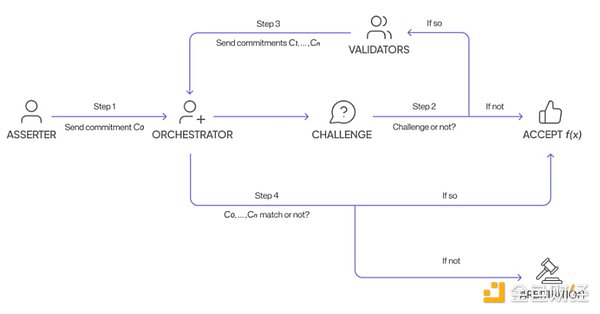
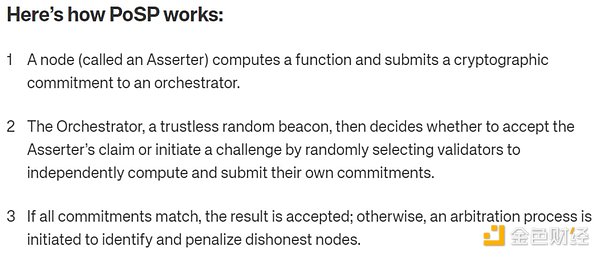
The simplest way to think about it is to think of it as a bus ticketing system.
Ticket inspectors only conduct random checks, so you might think that passengers would often take the risk of evading fares. But surprisingly, they don't do so because the penalties for fare evasion are strong enough to prevent passengers from cheating. As long as the fines far exceed the cost of purchasing the ticket, honesty will prevail.
Hyperbolic's SpML uses economic incentives to address the limitations of current verification mechanisms such as OpML and zkML. It provides both speed and security, achieving a good balance between the two, without a heavy computational burden.
What to watch out for? It assumes that everyone behaves rationally, which is not always the case.
If SpML works well in practice, it will change the rules of the game for decentralized AI applications, making trustless verification reasoning a reality.
2, Scalable Low-Cost Computing
Training AI is expensive. Electricity and computing access are the biggest costs faced by enterprises and startups. The cost of computing power required to train models doubles almost every 9 months.
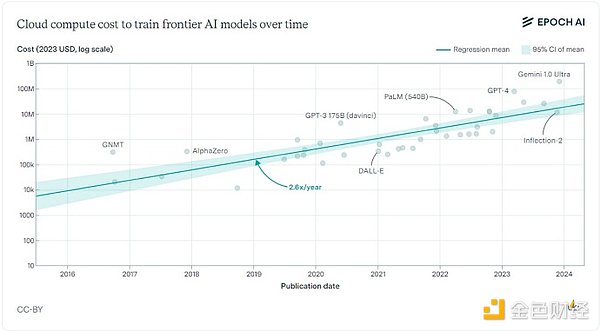
GPT-3 costs about $4 million in 2020, while GPT-4 will cost a jaw-dropping $190 million to train in 2023.
Only well-resourced organizations can survive. Smaller players and enthusiasts are squeezed out of the market by high costs. A postdoc at Stanford University had to stop his research because he couldn't afford the thousands of GPUs he needed.
A major challenge of decentralized computing networks is managing heterogeneous hardware—not just top-of-the-line Nvidia chips, but also a wide variety of GPUs.
Hyperbolic's decentralized operating system is the core of its computing network. It will seamlessly pool resources with built-in automatic scaling and fault tolerance.
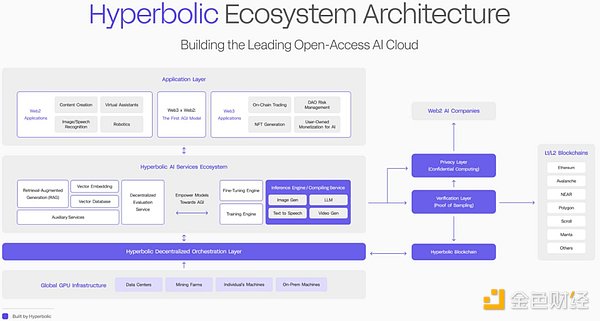
Hyperbolic’s breakthrough lies in how it handles this complexity.
· It provides flexibility by optimizing tensor operations on different hardware, from Nvidia to AMD GPUs.
· Hyperbolic’s compilation stack abstracts complexity, enabling developers to achieve high performance across different GPU setups without getting bogged down in deployment and configuration.
Other markets may offer decentralized GPUs, but they often lack the sophisticated optimizations that Hyperbolic can provide, placing the burden of performance tuning on the user.
Hyperbolic simplifies this through an API that provides access to AI models optimized for a variety of hardware, making global computing resources more accessible.
On August 15, Hyperbolic released an alpha-restricted version of its GPU marketplace, allowing 100 waiting members to try out the GPU rental function.
3、AIService Layer
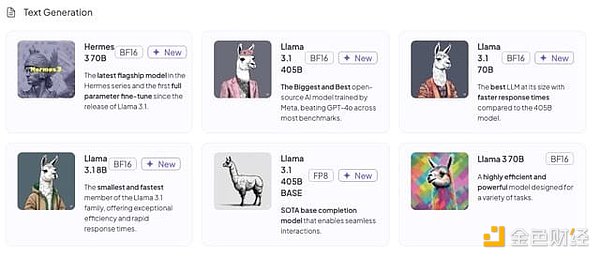
The next component of the Hyperbolic artificial intelligence ecosystem is the AI service layer, which provides functions such as reasoning, model training, model evaluation, and retrieval enhancement generation (RAG).
In the Hyperbolic app, you can easily run top open source models such as Llama 3.1 405B and Hermes 370B. To fine-tune the output, you can adjust hyperparameters such as max tokens, temperature, and top P.
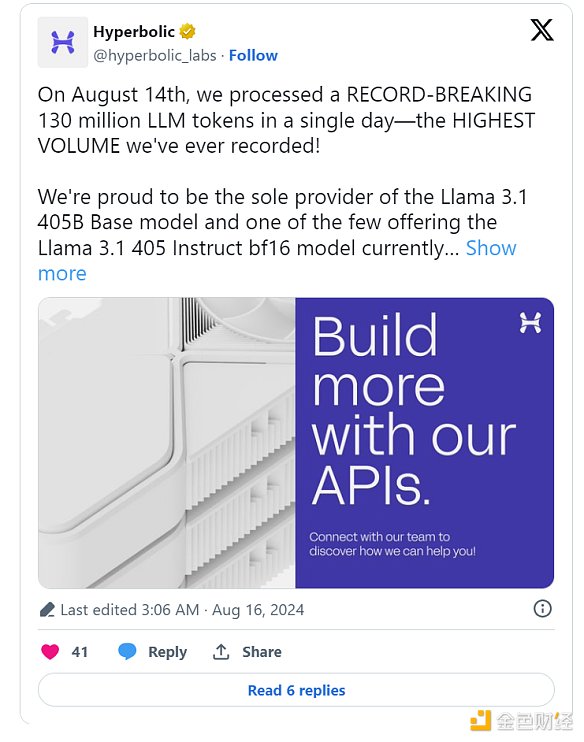
The Hyperbolic platform opens the door to innovative AI applications, including:
·AIAgent Revenue Sharing:Tokenize the ownership of AI agents to redistribute revenue.
·AIDAO:Use AI for governance decisions.
·FragmentedGPUOwnership:Allows users to own and trade fractions of GPUs.
4What role doesCryptoplay?
At the heart of Hyperbolic’s infrastructure is its blockchain, which underpins the orchestration, service, and validation layers. The blockchain handles settlement and governance for Hyperbolic’s open source AI cloud. It also supports the arbitration and validation mechanisms for PoSP technology.
While little is known about the blockchain yet, you can expect Hyperbolic to reveal more about this soon.
5, research-gradeAlpha
Hyperbolic is still in the testnet stage. They raised $7 million in a seed round led by Polychain Capital and Lightspeed Faction.
Interestingly, Hyperbolic is the exclusive provider of the Llama 3.1 405B Base model.
The Base model is the initial pre-trained version of LLM without fine-tuning or reinforcement learning with human feedback (RLHF). It has the following advantages: · Full support for fine-tuning of specific tasks · It is the starting point for advanced AI techniques, such as synthetic data generation or model distillation. 6. About the team Dr. Jasper (Yue) Zhang is the co-founder and CEO of Hyperbolic Labs. He was a senior blockchain researcher at Ava Labs and a quantitative researcher at Citadel Securities. He obtained a PhD in mathematics from the University of California, Berkeley in two years and won gold medals in both the Alibaba Global Mathematics Competition and the China Mathematical Olympiad.
Dr. Yuchen Jin is the co-founder and CTO of Hyperbolic Labs. He holds a PhD in Computer Systems and Networks from the University of Washington. He previously worked at OctoML, a company that provides infrastructure for running, tuning, and scaling generative AI applications.
7Our Thoughts
Overall, we are very excited about Hyperbolic. They are definitely one of the most noteworthy teams in the Crypto AI space.
Hyperbolic is more than just a computing power provider, innovations like PoSP and SpML also add new layers of trust and verification to decentralized AI.
It is very interesting to experiment with base models on Hyperbolic, especially because they are one of the few providers that can currently achieve this functionality. We can definitely believe in the open source AI commitment that supports them.
We wrote about Prime Intellect a few weeks ago. It remains to be seen whether Hyperbolic will focus on distributed AI training like Prime Intellect.
While we note that demand for compute power is typically sparse, this does not seem to be the case for Hyperbolic. They have shown early traction in the research market, attracting a lot of interest from researchers and developers.
 Kikyo
Kikyo













